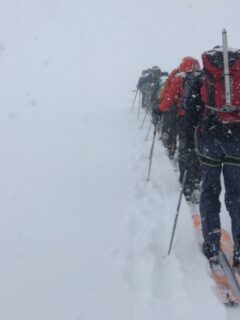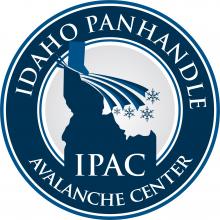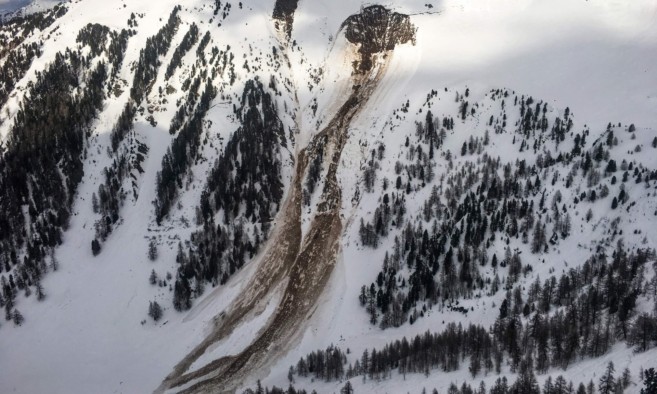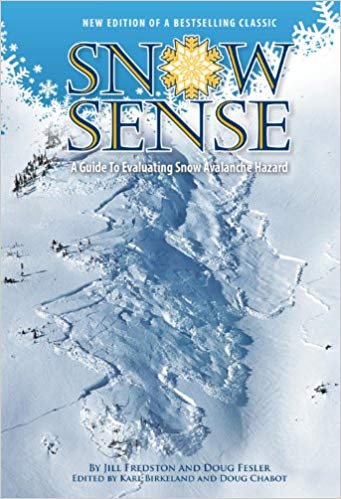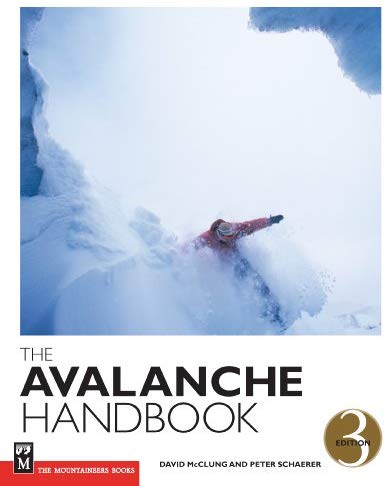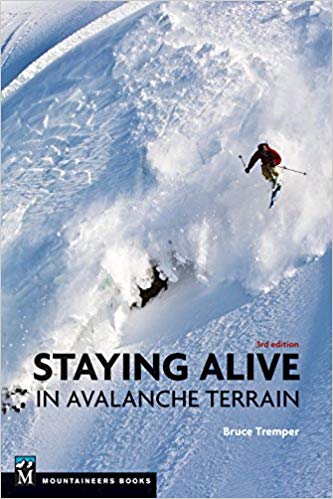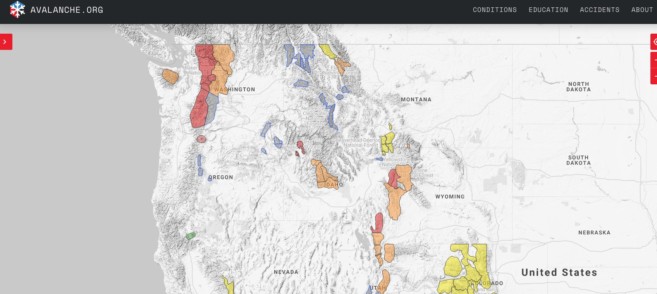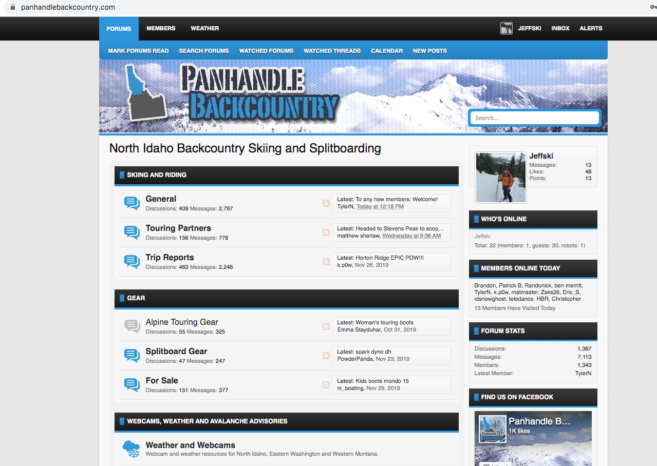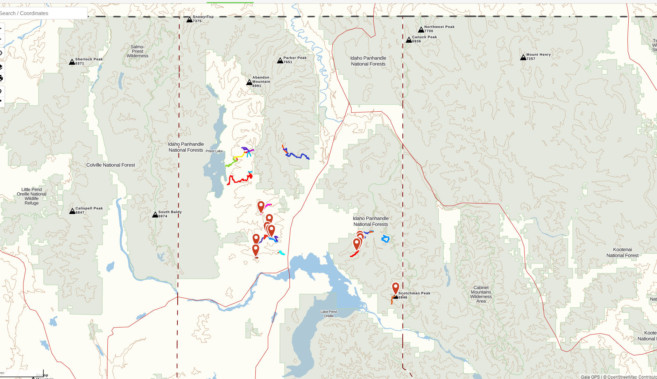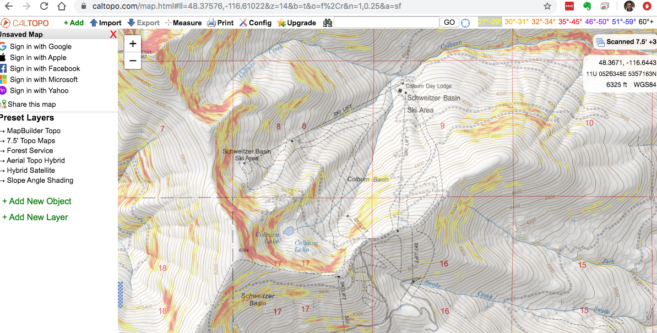If you’re heading out of the ski area, there’s no doubt about it – you’re heading into avalanche country. In the backcountry, there’s no Ski Patrol monitoring the snowfall, wind slabs and temperatures to determine where needs to be avalanche controlled. It is up to you and your ski touring partners to use the information and skills you have to determine when to go, where to go, and to plan safest route to get there.
On big snow days, I actually carry a probe, shovel, and beacon inbounds. Avalanches can and do happen in ski resorts, even with the amazing skills of the Ski Patrol at our resorts. Sometimes Mother Nature doesn’t let it go after a few explosives have been set off. Tt takes that 7th skier hitting that run of new powder to break it loose.
Rule number one when it comes to skiing in the backcountry? Don’t go outside of a ski area on your own. It’s just not a good idea, find a partner. Fall in a tree well on your own, not good. Break a leg on your own, bad too. Get caught in a slide with no one to find you, could be fatal.
Get Educated about Avalanches
I think the more you know, the better you can plan a safe route, and the better you can evaluate risks in the backcountry. As long as you treat your knowledge as a skill your building on, not a superweapon that will protect you in all circumstances.
The good news is that there is an increasing amount of great content online for being careful and planning ski touring routes in the backcountry. One great series I like is a series sponsored by Outdoor Research and Backcountry Magazine called Ski Mountaineering Skills with Andrew McLean. There are a bunch of movies in this series, all well done.
I highly recommend that you take an Avalanche Level 1 Class before ever setting foot in the backcountry. If you’ve taken one before, it might be worth taking a refresher if it’s been a while. Or, maybe you’re ready for a Level 2 class. You can never know too much about evaluating avalanche terrain and planning safe touring routes.
In these courses you’ll learn the basics of what causes Avalanches, what to avoid, how to properly use a shovel, probe and beacon, and how to execute an avalanche rescue. It is paramount that you – and your partner(s) – know how to do this.
Furthermore, an added benefit to taking these courses is that you’ll even learn about good spots to tour locally. Likeminded ski tourers and course instructors are often a wealth of knowledge when it comes to getting that local beta. I took mine in Sandpoint Idaho, through IPAC – The Idaho Panhandle Avalanche Center. It was super well done. Very informative, so much so that I made a short 3-minute movie about my experience – see below.
There are great avalanche courses offered throughout the United States and Canada. If you’re in the Alberta area, I have also heard great things about the Yamnuska Mountain Adventures AST 1 course.
Supplement your Avalanche Course with Online Materials
I’d recommend supplementing your Avalanche course with some online material, such as the Know Before You Go online program. It’s a great place to start. At some point, though you need to be in the snow with your tools to really learn.
This recent “Know Before You Go” video was an effort by The Utah Avalanche Center and the Colorado Avalanche Information Center. They teamed up with Avalanche Canada, Backcountry Access, the American Avalanche Association, the American Institute of Avalanche Research and Education, the National Avalanche Center, Sherpas Cinema, Red Bull Media House, Brainfarm, and others to bring you this beta which is unlike any other PSA you are likely to see.
Read Avalanche & Route Planning Books
I’d also recommend reading some books on backcountry route planning, snow science, and avalanche safety. It’s actually a prerequisite for some Avalanche courses! Some of the books are easy reads, some are a bit tougher, depends on what you’re interested in. Weather system formation, psychology of group dynamics, buried hoar frost…The topics are endless, but you can never know enough!
It’s important to maintain the mindset that no class, book, or online resource will guarantee that you will be SAFE in the backcountry. They will surely give you the tools to help you make an educated decisions and plan less risky routes. But it’s important to remember that the backcountry is still unpredictable. Even the most experienced avalanche experts have died while ski touring.
Monitor the Recent Conditions in Your Area
Beyond educating yourself on avalanche science and route planning theory, it’s important to understand the snow and weather conditions to help you plan your ski touring route.
If you’re planning a weekend tour, keep track of the weather trends and what’s happened in the snowpack throughout the week leading up. Stay informed throughout the year to understand the persistent weak layers that you should be concerned about and how to plan your route to avoid them.
Your best source for Avalanche predictions is your local Avalanche Center. For me, in the Panhandle of Idaho, it’s IPAC, The Idaho Panhandle Avalanche Center. They’ll post weekly updates on what they’re seeing with their testing in the Snowpack. Follow them on Facebook, and watch their movies – they’re amazing educational videos.
All major ski zones in the US and CANADA have avalanche info you can find online. In Canada it’s Avalanche.ca, and you can also follow them on social media.
In the US it’s Avalanche.org for all the avalanche forecasts and conditions.
A Silent Threat: The Impacts of Group Psychology
One of the main things I enjoyed in my reading and class was the topic on the Psychology of group dynamics and decision making. I find this topic fascinating. Often overlooked, understanding the dangers with people of different risk tolerances in your touring group, the Human Factor in avalanche Incidents, is huge.
As an example, one person in the group might project an image of knowledge (the Expert Halo) to the others, and so they follow him/her anywhere. Alternatively, maybe there’s a group goal to reach a certain peak that was set during planning, and that goal to reach that endpoint might overpower any danger signs you sense around you. Even furthermore, familiarity with terrain is a risk. “Oh I’ve skied Big Blue 20 times, it’s never slid on me.” You know what, it might slide on run number 21.
No matter how well you objectively understand the terrain, the conditions, and the risk, there are countless ways that group psychology can be the biggest risk of all.
There are, thankfully, different ways to help mitigate the detriments of group psychology. Before you start your ski tour, make sure you have a group discussion with your tour partners about risk. Anyone who sees anything – signs of recent slides, hears “Whumph” sounds under the snow or just doesn’t feel comfortable – speak up with no fear. Ski low angle stuff or just head back, and wait for another day. Select your touring partners carefully!
Belonging to a local online ski/board backcountry forum can be an amazing resource. Mine in Idaho is Panhandlebackcountry.com, I’m Jeffski on there by the way! If something like this doesn’t exist in your area, why not start one! It’s a great forum for learning about new routes, gathering beta, discussing risks and conditions, and sharing in the stoke about backcountry ski touring.
Find a local Facebook group for touring, again, we have one up in Sandpoint Idaho, it’s 7B BackCountry another amazing resource.
Using your Skills: Backcountry Ski Tour Planning
No matter where you’re going, or how you’re getting there, you need a plan. Establishing a route plan is important in order to:
- Make sure you’re not skiing off of cliffs
- Ensure that there are no terrain traps to ski through
- Evaluate avalanche conditions and terrain to make sure they are within your risk tolerance
- Establish contingencies that you and your group will use to call it a day based on risk assessment.
- Feel confident that you have packed all the right gear for the tour
While out in the backcountry, plan on carefully observing snow conditions around you as you watch and listen for potential risks. It’s always a good idea, to do a snow pit in a zone similar in altitude and exposure to where you might want to ski to learn more. Here’s a great checklist to review when you’re planning a trip.
Tools to Use for Tour planning
There are some great web tools to use for preplanning, and I’ll talk about some of them.
Google EARTH PRO
Google EARTH Pro – it’s free! Google Earth Pro is an amazing 3d terrain visualization tool. It works on your phone, tablet, and desktop, mac and windows. You can use it for pre-planning, but also for post visualization after if you capture your path in a GPS app like GAIA GPS. Here’s a link to a quick movie of a post visualization of our 7 day HAUTE ROUTE Trip using Google Earth.
CALTOPO
CALTOPO and their FREE Service for slope angle calculation is a game-changer. See terrain maps with slope angle grouped in zone ranges. Say you want to see 27 to 29 degrees color-coded for example, CALTOPO can do it. It is an amazing tool for finding safer ski zones and uphill travel zones. This way you can plan your route to avoid terrain traps and steeper slopes. They also have a paid service that lets you see their overlays on a google earth interactive 3d display – which is useful.
GAIA GPS
I mentioned it briefly earlier, but GAIA GPS is one of the main tools I use in conjunction with Google Earth. It’s the tool I also track my trips with and let’s me precache all my important data on my phone so I don’t need cell data in the backcountry- just a satellite signal. The paid version, which I use, has a CALTOPO slope angle layer in it so it is super useful on treks.
There you have it! The fundamental resources, tools, skills, and knowledge you should have to help plan safe backcountry ski touring routes. What other tools and suggestions do you have when planning your route? Let me know in the comments!
If you found this blog interesting there are two other connected blogs you should look at:
BLOG Taking a Backcountry Ski & Board Trip – The Different Options Available
BLOG Touring Gear and what you Need for Day and Multi-Day Tours
If you will be touring in the backcountry, I hope this blog will help motivate your educational process, whether it’s taking a class, or just reading some books. Be careful, listen closely to the local Avalanche forecasts, and bring the proper equipment and a partner you have confidence in. Have fun out there!

About Jeff Meeker – Jeff is an avid skier, outdoorsman, and technology guru, who’s love for skiing is at the same level as his wife and two kids. His passion for skiing started age 3, when his Swiss mother made it a requirement that he know how to ski. He spent the winter of ‘84 working in a Swiss ski school near Verbier, which his daughter decided to replicate in 2017. Jeff spends his time between Northern Virginia, Switzerland, and Sandpoint Idaho. He has two home ski mountains, La Tzoumaz, Switzerland, and Schweitzer, Sandpoint Idaho.

